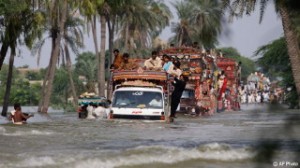A few weeks ago, I wrote about the opportunity and need for Haiti to redevelop sustainably after the devastating earthquake in 2010. I also discussed how construction in Bihar, India – after a flood completely washed away the area – could be a model for rebuilding homes in Haiti. Unfortunately, like Haiti and India, Pakistan also suffered from a natural disaster in 2010. In July, monsoon rains hit the Khyber Pakhtunkhwa, Sindh, Balochistan, and Punjab regions in Pakistan and affected over 20 million people. Hundreds of homes and buildings were destroyed, structural damage was estimated to be $4 billion, and about 2,000 people died in the flood. Needless to say, it was devastating, and rebuilding the area would certainly be challenging.
be $4 billion, and about 2,000 people died in the flood. Needless to say, it was devastating, and rebuilding the area would certainly be challenging.
However, architects and engineers from the Heritage Foundation (HF), a nonprofit that works to preserve the environment and culture of Pakistan, seized the opportunity to rebuild the affected areas of Pakistan in a more sustainable and environmentally friendly way. Hundreds of homes needed to be rebuilt. Instead of using the traditional materials and methods of using steel and cement, though, HF used local materials that are actually stronger and more readily available. They’re also environmentally friendly. The secret ingredients? Local stone, bamboo, mud, and lime.
It may sound like an interesting combination, but it’s an innovative strategy that works. The stone is used in the foundation of the house, and the bamboo is used to make the walls strong and sturdy. Bamboo also grows incredibly fast, making it a very sustainable choice. The mud and lime are surprisingly excellent insulators, and all together, a house can be built to last more than 20 years. Even if there are future floods – which are now projected because of increasing temperatures and climate change – these homes are expected to remain intact. Additionally, with the teamwork of just eight people, these green, structurally sound homes take only eight days to build. With commitment from the community, proper training, and enough dedication, the once-overwhelming task of redeveloping flood-affected areas becomes much more attainable.
The best part? These houses are much bigger and cleaner than those that were swept away by the flood. They had bigger kitchens and an attached toilet, which were two relative luxuries. I think it’s safe to say that these areas of Pakistan are not just rebuilding after the flood, but building back better and smarter than it was before.
Constructing these homes using local materials and the workforce has also stimulated the local economies. Different parts of the houses – like roof panels, for example – are supplied by different neighborhoods that were affected by the flood. The community truly works together to rebuild the area, and everyone benefits. These homes are an inspiration – not only is it possible to recover from a natural disaster, but it’s also possible to rebuild sustainably and in an environmentally friendly way. Additionally, these houses are stronger, cleaner, and sturdier than the houses were before the floods. Pakistan’s redevelopment plan, along with the plan in Bihar, can serve as a valuable model for countries like Haiti, which is still struggling to rebuild. The focus on strategy, sustainability, and involvement of the local community proves to be an extremely effective method of redevelopment.
This model can actually be applied to pretty much any type of new development. Sustainability is key. In today’s world, developing sustainably means utilizing readily available resources, using clean energy, and building structures that can withstand natural disasters and severe weather. This obviously takes innovation and great strategy, but it’s truly the only way we can build to last.
Rebecca Birnbaum is a Program and Research Intern for the SISGI Group focusing on nonviolent conflict resolution, nonprofit management, and sustainable development. She is a senior at the University of Michigan, where she studies Anthropology, Political Science, and Peace and Social Justice. To learn more about the SISGI Group, visit www.sisgigroup.org.


